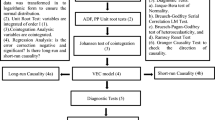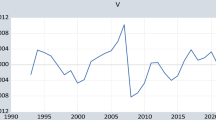Abstract
Achieving a long-term food security and preventing hunger include a better nutrition through sustainable systems of production, distribution, and consumption. Nonetheless, the quest for an alternative to increasing global food supply to meet the growing demand has led to the use of poor agricultural practices that promote climate change. Given the contribution of the agricultural ecosystem towards greenhouse gas (GHG) emissions, this study investigated the causal nexus between carbon dioxide emissions and agricultural ecosystem by employing a data spanning from 1961 to 2012. Evidence from long-run elasticity shows that a 1 % increase in the area of rice paddy harvested will increase carbon dioxide emissions by 1.49 %, a 1 % increase in biomass-burned crop residues will increase carbon dioxide emissions by 1.00 %, a 1 % increase in cereal production will increase carbon dioxide emissions by 1.38 %, and a 1 % increase in agricultural machinery will decrease carbon dioxide emissions by 0.09 % in the long run. There was a bidirectional causality between carbon dioxide emissions, cereal production, and biomass-burned crop residues. The Granger causality shows that the agricultural ecosystem in Ghana is sensitive to climate change vulnerability.


Similar content being viewed by others
References
Allen MR, Frame DJ, Huntingford C, Jones CD, Lowe JA, Meinshausen M, Meinshausen N (2009) Warming caused by cumulative carbon emissions towards the trillionth tonne. Nature 458:1163–1166
Asumadu-Sarkodie S, Owusu PA (2016a) Carbon dioxide emission, electricity consumption, industrialization and economic growth nexus: the Beninese case. Energy Sources, Part B: Economics, Planning, and Policy. doi:10.1080/15567249.2016.1217286
Asumadu-Sarkodie S, Owusu PA (2016b) Carbon dioxide emissions, GDP, energy use and population growth: a multivariate and causality analysis for Ghana, 1971-2013. Environ Sci Pollut Res Int 23:13508–13520. doi:10.1007/s11356-016-6511-x
Asumadu-Sarkodie S, Owusu PA (2016c) The causal effect of carbon dioxide emissions, electricity consumption, economic growth and industrialization in Sierra Leone. Energy Sources, Part B: Economics, Planning, and Policy. doi:10.1080/15567249.2016.1225135
Asumadu-Sarkodie S, Owusu PA (2016d) The causal nexus between energy use, carbon dioxide emissions and macroeconomic variables in Ghana. Energy Sources, Part B: Economics, Planning, and Policy. doi:10.1080/15567249.2016.1225134
Asumadu-Sarkodie S, Owusu PA (2016e) Feasibility of biomass heating system in Middle East Technical University. Northern Cyprus Campus Cogent Engineering 3:1134304. doi:10.1080/23311916.2015.1134304
Asumadu-Sarkodie S, Owusu PA (2016f) Multivariate co-integration analysis of the Kaya factors in Ghana. Environ Sci Pollut Res Int 23:9934–9943. doi:10.1007/s11356-016-6245-9
Asumadu-Sarkodie S, Owusu PA (2016g) Recent evidence of the relationship between carbon dioxide emissions, energy use, GDP and population in Ghana: a linear regression approach energy sources, part B: economics, planning, and policy. doi:10.1080/15567249.2016.1208304
Asumadu-Sarkodie S, Owusu PA (2016h) The relationship between carbon dioxide and agriculture in Ghana: a comparison of VECM and ARDL model. Environ Sci Pollut Res Int 23:10968–10982. doi:10.1007/s11356-016-6252-x
Awasthi A, Singh N, Mittal S, Gupta PK, Agarwal R (2010) Effects of agriculture crop residue burning on children and young on PFTs in North West India. Sci Total Environ 408:4440–4445
Bhatia A, Jain N, Pathak H (2013) Methane and nitrous oxide emissions from Indian rice paddies, agricultural soils and crop residue burning. Greenhouse Gases-Science and Technology 3:196–211. doi:10.1002/ghg.1339
Couwenberg J, Dommain R, Joosten H (2010) Greenhouse gas fluxes from tropical peatlands in south-east Asia. Glob Chang Biol 16:1715–1732
Davis SJ, Caldeira K, Matthews HD (2010) Future CO2 emissions and climate change from existing energy infrastructure. Science 329:1330–1333
Dobbie KE, McTaggart IP, Smith KA (1999) Nitrous oxide emissions from intensive agricultural systems: variations between crops and seasons, key driving variables, and mean emission factors. J Geophys Res-Atmos 104:26891–26899. doi:10.1029/1999jd900378
FAO (2015) FAO statistical yearbooks-world food and agriculture. http://faostat3.fao.org/home/E. Accessed 24 October 2015
FAO (2016) Introduction & status of the forestry sector in Ghana. http://www.fao.org/docrep/003/ab567e/AB567E02.htm. Accessed 16 July 2016
Fitzgerald G et al (2010) Future effects of elevated CO2 on wheat production—an overview of FACE research in Victoria, Australia. In: Food security from sustainable agriculture. 15th Agronomy Conference, 15–18 November 2010, Lincoln, New Zealand. Australian Society of Agronomy, Gosford, NSW
Friedlingstein P, Solomon S (2005) Contributions of past and present human generations to committed warming caused by carbon dioxide. Proc Natl Acad Sci U S A 102:10832–10836
Granger CW (1969) Investigating causal relations by econometric models and cross-spectral methods. Econometrica 424–438
Granger CW (1988) Some recent development in a concept of causality. J Econ 39:199–211
Griggs D et al (2013) Policy: sustainable development goals for people and planet. Nature 495:305–307
Hou Y, Velthof GL, Oenema O (2015) Mitigation of ammonia, nitrous oxide and methane emissions from manure management chains: a meta-analysis and integrated assessment. Glob Chang Biol 21:1293–1312
Huang Y, Zhang W, Zheng X, Li J, Yu Y (2004) Modeling methane emission from rice paddies with various agricultural practices. Journal of Geophysical Research: Atmospheres 109:1984–2012
Hughes DJ, West JS, Atkins SD, Gladders P, Jeger MJ, Fitt BD (2011) Effects of disease control by fungicides on greenhouse gas emissions by UK arable crop production. Pest Manag Sci 67:1082–1092
Hungate BA et al (2009) Assessing the effect of elevated carbon dioxide on soil carbon: a comparison of four meta-analyses. Glob Chang Biol 15:2020–2034
Huntingford C, Lowe JA, Gohar LK, Bowerman NH, Allen MR, Raper SC, Smith SM (2012) The link between a global 2 C warming threshold and emissions in years 2020, 2050 and beyond. Environ Res Lett 7:014039
IPCC (2014) Climate change 2014: mitigation of climate change. https://www.ipcc.ch/report/ar5/wg3/. Accessed 16 April 2016
Keith DW (2009) Why capture CO2 from the atmosphere? Science 325:1654–1655
Kludze H, Deen B, Weersink A, van Acker R, Janovicek K, De Laporte A, McDonald I (2013) Estimating sustainable crop residue removal rates and costs based on soil organic matter dynamics and rotational complexity. Biomass Bioenergy 56:607–618
Kutcher H, Malhi S (2010) Residue burning and tillage effects on diseases and yield of barley (Hordeum vulgare) and canola (Brassica napus). Soil Tillage Res 109:153–160
Li CS (2000) Modeling trace gas emissions from agricultural ecosystems. Nutr Cycl Agroecosyst 58:259–276. doi:10.1023/A:1009859006242
Li Y, Lin ED (2000) Emissions of N2O, NH3 and NOx from fuel combustion, industrial processes and the agricultural sectors in China. Nutr Cycl Agroecosyst 57:99–106
Li Y, Barton L, Chen D (2012) Simulating response of N2O emissions to fertiliser N application and climatic variability from a rain-fed and wheat-cropped soil in Western Australia. J Sci Food Agric 92:1130–1143
Meinshausen M et al (2009) Greenhouse-gas emission targets for limiting global warming to 2 C. Nature 458:1158–1162
Mohamad R, Verrastro V, Al Bitar L, Roma R, Moretti M, Al Chami Z (2015) Effect of different agricultural practices on carbon emission and carbon stock in organic and conventional olive systems. Soil Research
Mohiuddin O, Asumadu-Sarkodie S, Obaidullah M (2016a) The relationship between carbon dioxide emissions, energy consumption, and GDP: a recent evidence from Pakistan. Cogent Engineering 3:1210491. doi:10.1080/23311916.2016.1210491
Mohiuddin O, Mohiuddin A, Obaidullah M, Ahmed H, Asumadu-Sarkodie S (2016b) Electricity production potential and social Benefits from Rice husk, a case study in Pakistan. Cogent Engineering 3:1177156. doi:10.1080/23311916.2016.1177156
Mosier A, Kroeze C, Nevison C, Oenema O, Seitzinger S, Van Cleemput O (1998) Closing the global N2O budget: nitrous oxide emissions through the agricultural nitrogen cycle. Nutr Cycl Agroecosyst 52:225–248
Owusu P, Asumadu-Sarkodie S (2016) A review of renewable energy sources. Sustainability Issues and Climate Change Mitigation Cogent Engineering 3:1167990. doi:10.1080/23311916.2016.1167990
Owusu PA, Asumadu-Sarkodie S, Ameyo P (2016) A review of Ghana’s water resource management and the future prospect. Cogent Engineering 3:1164275. doi:10.1080/23311916.2016.1164275
Parton WJ, Gutmann MP, Merchant ER, Hartman MD, Adler PR, McNeal FM, Lutz SM (2015) Measuring and mitigating agricultural greenhouse gas production in the US Great Plains, 1870–2000. Proc Natl Acad Sci 112:E4681–E4688
Ramanathan V, Feng Y (2008) On avoiding dangerous anthropogenic interference with the climate system: formidable challenges ahead. Proc Natl Acad Sci 105:14245–14250
Sanford RA et al (2012) Unexpected nondenitrifier nitrous oxide reductase gene diversity and abundance in soils. Proc Natl Acad Sci 109:19709–19714
Shcherbak I, Millar N, Robertson GP (2014) Global metaanalysis of the nonlinear response of soil nitrous oxide (N2O) emissions to fertilizer nitrogen. Proc Natl Acad Sci 111:9199–9204
Smil V (1999) Nitrogen in crop production: an account of global flows. Glob Biogeochem Cycles 13:647–662
Steffen W et al (2011) The Anthropocene: from global change to planetary stewardship. Ambio 40:739–761
Tilman D, Cassman KG, Matson PA, Naylor R, Polasky S (2002) Agricultural sustainability and intensive production practices. Nature 418:671–677
Vasilica S, Fîntîneru G, Mihalache M (2014) Multicriteria analysis of the effects of field burning crop residues. Notulae Botanicae Horti Agrobotanici Cluj-Napoca 42:255–262
Viana M et al (2013) Evidence of biomass burning aerosols in the Barcelona urban environment during winter time. Atmos Environ 72:81–88
Wigley TM (2005) The climate change commitment. Science 307:1766–1769
World Bank (2014) World Development Indicators. http://data.worldbank.org/country. Accessed 24 October 2015
Xu P, Zhang Y, Gong W, Hou X, Kroeze C, Gao W, Luan S (2015) An inventory of the emission of ammonia from agricultural fertilizer application in China for 2010 and its high-resolution spatial distribution Atmospheric Environment
Zeebe RE (2013) Time-dependent climate sensitivity and the legacy of anthropogenic greenhouse gas emissions Proceedings of the National Academy of Sciences 110:13739–13744
Zhang T, Wooster MJ, Green DC, Main B (2015) New field-based agricultural biomass burning trace gas, PM 2.5, and black carbon emission ratios and factors measured in situ at crop residue fires in Eastern China. Atmospheric Environment
Acknowledgment
SAS expresses his sincere gratitude to Prof. Dr. Ali Cevat Taşıran of Middle East Technical University, Northern Cyprus campus, who provided the seed and earlier guidance for this research.
Author information
Authors and Affiliations
Corresponding author
Additional information
Responsible editor: Philippe Garrigues
Electronic supplementary material
ESM 1
(DOCX 33 kb)
Rights and permissions
About this article
Cite this article
Asumadu-Sarkodie, S., Owusu, P.A. The causal nexus between carbon dioxide emissions and agricultural ecosystem—an econometric approach. Environ Sci Pollut Res 24, 1608–1618 (2017). https://doi.org/10.1007/s11356-016-7908-2
Received:
Accepted:
Published:
Issue Date:
DOI: https://doi.org/10.1007/s11356-016-7908-2




